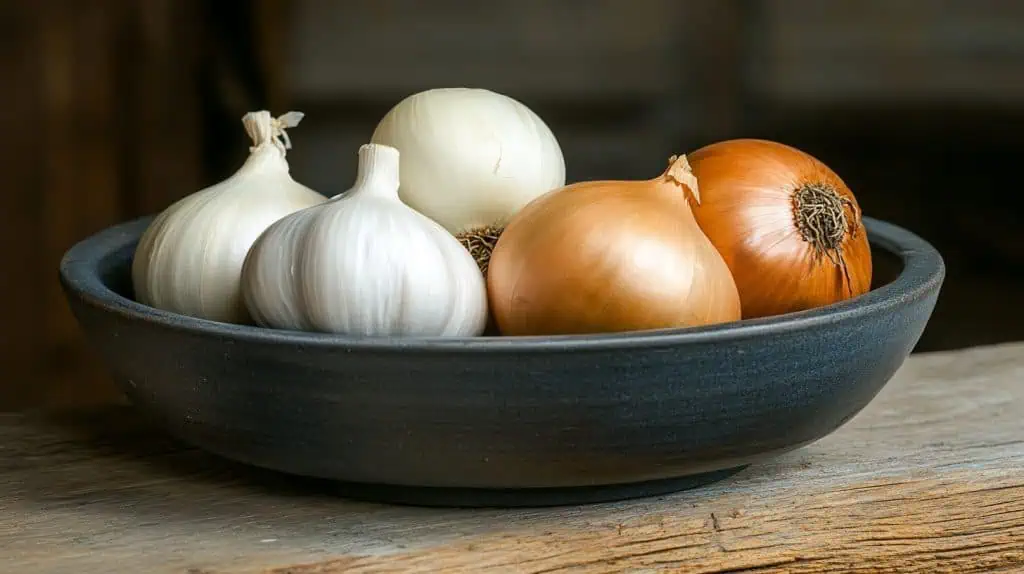Your body produces its own “master antioxidant” that may hold the key to slowing down the aging process. Glutathione could just be the most powerful antioxidant you’ve never heard of!
It has been gaining lots of attention in the anti-aging and skincare communities – and for good reason!
This powerful molecule exists in nearly every cell of your body and plays a crucial role in protecting against oxidative stress, detoxification, and cellular repair.
With research linking declining glutathione levels to various signs of aging, many are turning to this compound to reverse that.
See which other nutrients could help you live longer from our full list of anti-aging supplements.

What Is Glutathione and How Does It Combat Aging?
Glutathione is what scientists call a tripeptide – basically, a small protein made up of three amino acids (cysteine, glutamic acid, and glycine).
The Body’s Primary Antioxidant Defense System
That’s the nerdy stuff out the way. What’s important is what this powerful molecule does in your body. It’s like having your own internal cleaning crew working 24/7.
Your body produces glutathione naturally in every single cell, which should tell you something about how important it is. It serves as your body’s primary antioxidant defense system… which made me wonder why I’d never heard of it!
How Glutathione Levels Naturally Decline with Age
The tricky thing about glutathione is that levels start dropping as we age. Research shows that we lose approximately 1% of our glutathione production every year after age 20.
By the time I hit 50, I had potentially lost 30% of my natural production! No wonder those lines started showing up, and my energy levels weren’t what they used to be.
The connection between aging and glutathione really clicked for me when I understood oxidative stress. You’ve probably heard about free radicals – those unstable molecules that damage cells and accelerate aging.
Well, oxidative stress happens when there are too many free radicals and not enough antioxidants to neutralize them. It’s like having a rust problem inside your body that slowly corrodes your cells over time.
Some people report a huge difference in their skin’s appearance after three months of supporting their glutathione levels. It helps regulate melanin production, which explains why it’s become so popular for skin brightening.
Glutathione’s Dual Roles
What makes glutathione especially powerful is its dual role in your body. Not only does it neutralize those free radicals I mentioned, but it also helps your body detoxify harmful substances.
So it’s a cleanup crew and a shield. In today’s world, where we’re constantly exposed to environmental toxins, processed foods, and stress, this detoxification function is even more important.
Oxidative Stress, Aging, and Protective Functions
I’ve learned that supporting my glutathione levels isn’t just about looking younger – it’s about feeling better, too. When your levels are optimized, you may notice improved energy, clearer thinking, and better recovery after exercise.
These benefits make sense when you consider that glutathione helps protect mitochondria, the little powerhouses in your cells that produce energy.
The most effective way to support glutathione isn’t through a single supplement or food. It’s about creating an environment in your body where glutathione can thrive naturally.
This includes eating sulfur-rich foods (like garlic and onions), getting quality sleep, managing stress (or trying to!), and avoiding things that deplete glutathione like alcohol and excessive medication.
The Science-Backed Benefits of Glutathione for Anti-Aging
When I first started researching glutathione, I was pretty skeptical. Just like with CoQ10 and resveratrol, there were plenty of bold claims floating around. Would these stand up any better?
After digging through the research and talking to medical people, I was genuinely surprised by the wealth of scientific backing behind this molecule.
Glutathione’s Ability to Reduce Oxidative Damage
The research on glutathione’s ability to reduce oxidative damage in cells is pretty impressive. In one study, researchers measured oxidative stress markers in participants before and after glutathione supplementation.
The results showed a significant decrease in these markers after just 6 weeks. This makes perfect sense when you understand that oxidative damage is like internal “rusting” that happens as we age.
Reduction in Wrinkles
The skin benefits of glutathione are what initially caught my attention. A clinical trial showed participants experiencing measurable reductions in wrinkles and improved skin elasticity after 12 weeks of glutathione supplementation (NCBI).
The most dramatic improvements were seen in hyperpigmentation reduction, with dark spots fading by up to 30% in some subjects.
Supplement Doubts
While glutathione’s benefits are unquestionable, whether supplements actually work has proved controversial in the medical community.
Some research suggests your body may not effectively absorb it in regular pill form. Sublingual glutathione (slipped under the tongue, avoiding the digestive system) may raise glutathione levels in your body.
Another form of the supplement, called liposomal glutathione, is also thought to be more effective than standard glutathione.
Glutathione’s Role in Protecting Telomeres
Here’s where things get really interesting – the telomere connection! Telomeres are these protective caps on our DNA that naturally shorten as we age.
Think of them like the plastic tips on shoelaces that prevent fraying. Some compelling research suggests that glutathione helps protect these telomeres from damage.
Published research shows that individuals with higher glutathione levels tend to have longer telomeres compared to age-matched controls (MedCrave).
This might explain why some people seem to age more gracefully than others.
Improved Mitochondrial Function and Cellular Energy
Many people report an energy boost with glutathione supplementation. And the science shows improved mitochondrial function with higher levels of glutathione.
These little powerhouses in our cells produce ATP, which is basically our cellular energy currency. One study demonstrated that glutathione supplementation improved mitochondrial efficiency by up to 15% in older adults (Frontiers).
Creduced Inflammation with Increased Glutathione
The inflammation connection might be the most important piece of the puzzle. Chronic inflammation is behind so many aspects of aging—from joint pain to cognitive decline.
Several clinical studies have shown that increasing glutathione levels leads to significant reductions in key inflammatory markers (like IL-6 and TNF-alpha).
In one particular study, participants with higher glutathione levels showed inflammation biomarkers similar to people 5-10 years younger!
Consistency
What really sold me on glutathione wasn’t just the individual studies but the consistency of results across different research teams.
Scientists aren’t always known for agreeing with each other, so when multiple independent research groups reach similar conclusions, that’s when I start paying attention.
The evidence for glutathione’s anti-aging benefits has been replicated in labs across the world. It’s just supplements where the jury’s still out.
If you’re considering taking glutathione supplements for anti-aging, don’t expect overnight miracles. The studies typically show significant results after 2-3 months of consistent use.

Glutathione’s Impact on Skin Health and Appearance
Here’s how glutathione actually works its magic on your skin. Essentially, it inhibits an enzyme called tyrosinase, which is responsible for producing melanin in your skin.
Unlike skin products that barely penetrate the surface, glutathione works at the cellular level, addressing the root cause of pigmentation issues.
How Glutathione Helps Reduce Melanin Production
By reducing the production of melanin, glutathione helps create a more even distribution of pigment throughout your skin.
It doesn’t bleach your skin (a common misconception) but rather helps regulate pigment production for a more balanced tone.
Benefits for Collagen Production and Skin Elasticity
What surprised me most was glutathione’s impact on collagen production. If you thought you needed expensive collagen supplements for that, turns out glutathione plays a crucial supporting role!
By protecting skin cells from oxidative damage, glutathione helps maintain the integrity of collagen fibers, which are essential for skin elasticity.
Protection Against UV Damage and Photoaging
The protection against UV damage is where glutathione really shines. Glutathione helps neutralize the free radicals generated by UV exposure before they can damage your skin cells.
It doesn’t replace sunscreen, but it provides an additional layer of protection from within. Think of it as internal sunscreen working alongside your external one!
Before and After Results for Skin Appearance
My dermatologist explained that glutathione’s skin benefits also extend to conditions like melasma and post-inflammatory hyperpigmentation.
The research indicates that glutathione can reduce melanin by up to 40% in affected areas over time, which is pretty remarkable – but consistency is key.
Most of the clinical studies show significant results around the 8-12 week mark, so patience is definitely required.
The combination of glutathione and vitamin C is exciting the skincare business. These two work synergistically – vitamin C helps recycle glutathione in the body, making it even more effective.
If you’re considering glutathione for skin health, just remember that results vary based on your individual biochemistry, age, and skin concerns.
Top Glutathione Supplements and Products for 2025
The form of glutathione you choose makes a HUGE difference in effectiveness. Traditional oral glutathione often gets broken down in the digestive tract before it can reach your cells.
Different forms of glutathione Supplements
The game-changer for many has been discovering liposomal glutathione, which wraps the molecule in little fat bubbles that protect it through digestion.
Acetyl glutathione is another form that’s been gaining popularity in 2025. The acetyl group attached to the molecule helps it pass through the digestive system intact.
Supplements Comparison
Now, let’s talk about the different ways to get glutathione into your system.
Oral supplements are obviously the most convenient, but they’re not the only option. Topical glutathione products like serums and creams have flooded the market in 2025.
They’re great for targeting specific skin concerns like dark spots, but they don’t provide the systemic benefits you get from internal supplementation.
Intravenous glutathione treatments are definitely the “luxury car” of the glutathione world. But here’s the reality check: at $150-300 per session, it’s not sustainable for most of us! (And you need to keep going back for maintenance treatments.)
Leading Glutathione Products
Recommended Dosages
Regarding supplement dosage, most research points to 250-1,000mg daily for general anti-aging benefits. To maximize its effects, it is best to split up doses rather than take a single large dose each day.
Higher isn’t always better, though! Everyone’s sweet spot is different, so starting low and gradually increasing works best.
Before starting any glutathione supplementation regimen, it’s important to consult with your healthcare provider about potential risks and side effects that could arise from taking excessive amounts over time.
Cost Comparison and Value Analysis of Top Products
Cost comparison is where things get interesting.
- The cheapest option – basic glutathione capsules – runs about $20-30 monthly.
- The mid-range liposomal products ($40-70 monthly) consistently report the best value in terms of results per dollar spent by consumers.
- The premium IV treatments, while effective, came out to about $1,200 for a series of 6 sessions – effective but definitely a splurge!
While it’s tempting to buy larger quantities to save money, I recommend starting with the smallest size, even if the per-unit cost is higher. No point saving 15% on something that doesn’t work for your body!
The newest trend I’ve been exploring in 2025 is glutathione precursor supplements. Instead of taking glutathione directly, precursors provide the building blocks your body needs to make its own glutathione.
NAC (N-acetyl cysteine) and glutamine are very popular, especially when combined with glycine and vitamin C. This approach is generally more affordable at $30-40 monthly.

Natural Ways to Boost Your Body’s Glutathione Production
Here are some dietary powerhouses that can naturally boost your glutathione levels:
- Sulfur-rich foods like onions and garlic
- Foods rich in selenium, like beef, chicken, fish, organ meats, cottage cheese, brown rice, and Brazil nuts
- Cruciferous vegetables like broccoli, Brussels sprouts, cauliflower, kale, and watercress
- Glutathione-rich foods like spinach, avocados, asparagus, and okra
- Foods rich in cysteine, such as whey protein, may increase glutathione
Getting the right supporting nutrients can make a big difference. Vitamin C works synergistically with glutathione, helping to recycle it in your body.
Key Nutrients that Support Glutathione Synthesis
Adding a quality vitamin C supplement or eating more berries, citrus fruits, and bell peppers can amplify the benefits. And it’s the same story with vitamin D.
Just one or two Brazil nuts a day can provide your entire selenium requirement – who knew something so simple could be so powerful? I keep a small container of them on my kitchen counter as a reminder.
The B vitamins, especially B6, B9 (folate), and B12, are critical co-factors for glutathione production. Think leafy greens and legumes, or just sprinkle nutritional yeast on your food.
Exercise and its Impact on Glutathione Levels
You don’t have to go mad! Moderate, consistent exercise boosts glutathione, while excessive exercise can temporarily deplete it!
Finding that sweet spot of 30-40 minutes of moderate activity most days of the week can give you the best results. Make morning walks or swimming sessions non-negotiable parts of your daily routine.
Sleep Quality and Glutathione Production Connection
Poor sleep sabotages your body’s production of glutathione – as well as triggering oxidative stress, leaving your cells vulnerable to damage.
Commit to 7-8 hours every night, and not only will your energy improve, but your skin quality might just improve, too!
Lifestyle Factors that Deplete Glutathione
On the flip side, I’ve become much more aware of the factors that deplete glutathione. Stress is the biggest culprit.
Learning to incorporate stress management techniques like meditation and deep breathing always felt a bit too woo-woo to me. However, I do try and always find it’s worth the effort.
Next up, alcohol! I used to enjoy my nightly glass (ok, sometimes two!) of red wine, justifying it with all those articles about resveratrol benefits.
When I experimented with reducing my alcohol consumption to just weekend social occasions, the improvement in… EVERYTHING (sleep, energy, cognition, face sagging) was unmistakable.
Environmental toxins and pollution can also drain your glutathione reserves. Not much you can do about the traffic outside! But now I’m more aware of cleaning products, plastics, and what I use on my skin.
Just using a quality water filter is a simple change that supports your body’s detoxification systems.
The most valuable lesson from my glutathione journey has been understanding that consistency matters more than perfection.
Some days I still don’t get enough sleep or I indulge in foods that aren’t optimal, but maintaining these natural glutathione-boosting practices most of the time gets results.
It’s great to know that many of the keys to maintaining youthful energy and appearance are accessible through simple daily choices.
Potential Side Effects and Safety Considerations
Taking glutathione supplements long-term has been linked to lower zinc levels. Inhaled glutathione may trigger asthma attacks in people who have asthma. Symptoms may include wheezing.
The most common side effect is digestive discomfort, so oral supplements should be taken with food. And gradually increasing the dose over several weeks gives your body time to adjust.
Some people report skin rashes or itching when starting a glutathione skin cream. Try and do a patch test first – you might be sensitive to one of the preservatives in the formulation rather than the glutathione itself.
The zinc sulfate sometimes included in glutathione formulations can give some people nausea. Switching to a zinc-free formula should do the trick..
These little details about formulations can make or break your experience with supplements. I’ve learned to scrutinize ingredient lists much more carefully now!
Drug Interactions
With any nutrient, there are always drug or supplement interactions. And the older we get, the more pills seem to be waiting for us every morning!
Glutathione can enhance the effects of certain blood pressure medications. This doesn’t mean you can’t take both, but your doctor might need to adjust dosages accordingly.
Certain chemotherapy drugs rely on oxidative stress to kill cancer cells, and glutathione could potentially interfere with their effectiveness.
There is always ongoing research in this area, but it highlights why discussing supplements with healthcare providers is crucial when undergoing medical treatment.
Safety Profile
The different administration methods of glutathione come with varying safety profiles. Oral supplementation is generally the safest route but has the lowest bioavailability.
Liposomal forms can improve absorption significantly with minimal side effects. And if you opt for injections, you have the risk of infection.
IV glutathione treatments definitely deliver the most dramatic results, but they also come with the highest risk profile. Some people report experiencing mild allergic reactions.
This highlights why these treatments should only be administered by qualified healthcare professionals who can respond to potential reactions.
Special Considerations
Experts don’t know if taking glutathione is safe during pregnancy and breastfeeding. We need more research to make sure, so it’s not worth the risk.
For elderly individuals, glutathione can be beneficial but may require dosage adjustments. Kidney health becomes more delicate with age, and it’s important for metabolizing supplements.
People with asthma need to be extra careful with glutathione. Inhaled glutathione (a form sometimes used for respiratory conditions) can trigger bronchospasm in some asthmatics.
How to Monitor for Adverse Reactions
Try to keep a simple health journal noting any new supplements, dosage changes, and any symptoms that appear. It can really help work out what is affecting your body.
Regular blood work is another important monitoring tool if you’re taking glutathione long-term.
Annual comprehensive metabolic panels check liver and kidney function, which helps ensure these vital detoxification organs are handling the supplement well.
You could also get checked for zinc and copper levels occasionally, as high-dose glutathione supplementation may affect the balance of these minerals.
If you experience any unusual symptoms after starting glutathione, don’t just push through hoping they’ll resolve.
Symptoms like persistent headaches, unusual fatigue, skin reactions, or changes in digestion should prompt you to stop the supplement temporarily and consult a healthcare provider.
It’s not always the glutathione itself, but perhaps fillers or the specific form you’re taking that’s causing issues.
My own personal supplement rules are: Start low, go slow, monitor your response, and work with knowledgeable healthcare providers.

Combining Glutathione with Other Anti-Aging Strategies
Glutathione works best as part of a comprehensive approach, not as a standalone solution.
Synergistic Effects with Antioxidants
The synergistic relationship between glutathione and other anti-aging antioxidants is worth knowing.
Vitamin C is glutathione’s best friend because it helps recycle glutathione in the body – making each molecule work harder and longer.
Vitamin E works alongside glutathione in a similar tag-team fashion. These antioxidants support each other’s functions, creating what the scientists call a “network effect”.
Alpha-lipoic acid (ALA) not only fights free radicals on its own but also helps regenerate both glutathione and vitamins C and E after they’ve done their job neutralizing free radicals.
Integration with Standard Anti-aging Skincare Ingredients
Peptide serums and glutathione supplementation are another winning combination. The peptides support collagen production externally, while glutathione helps protect existing collagen internally.
Niacinamide (vitamin B3) products paired well with glutathione. Both support even skin tone and address hyperpigmentation through different mechanisms.
Diet, Exercise, and Stress Management
The lifestyle components of a glutathione-centric anti-aging approach are just as important as the supplements and skincare. No amount of glutathione can counteract the effects of poor sleep and chronic stress.
Prioritizing 7-8 hours of quality sleep has become my No.1 health priority. It’s the one thing that affects everything else.
Exercise is another crucial piece of the puzzle. I’m not talking about marathon training here – just 30 minutes of brisk walking most days, with some strength training a couple of times a week.
This moderate approach seems to hit the sweet spot for enhancing glutathione’s benefits. Miss exercise for a few days and you’ll feel the difference.
Diet also plays a big role in maximizing glutathione benefits. I have found that following a predominantly Mediterranean-style diet rich in colorful vegetables, healthy fats, and moderate protein provide the best foundation.
If you’re considering integrating glutathione into your anti-aging protocol, my hard-earned advice is to start with the foundations first.
Optimize sleep, manage stress, maintain moderate exercise, and clean up your diet before adding supplements. Then, introduce glutathione alongside its synergistic partners rather than in isolation.
Be patient – most people observe improvements coming after about 3-4 months of consistent implementation.
The Bottom Line
Glutathione represents one of the most promising natural approaches to combating the aging process from within.
This powerful antioxidant works at the cellular level to neutralize free radicals, support detoxification, and potentially slow numerous aspects of aging.
However you choose to boost your levels, the science suggests that maintaining optimal glutathione could be a cornerstone of any effective anti-aging strategy.
Editorial Process
We believe in writing honest and unbiased reviews based on real-world experience. For more details, read our editorial process.
Some of the links in this article may be affiliate links, which can compensate us at no cost to you if you make a purchase. These are products we’ve personally used and tested. This site is not intended to provide financial or health advice. You can read our affiliate disclosure in our privacy policy.
Richard Riviere is a former 9-5er who was fat, frazzled, and fifty.
“There has to be more to life than this”, he decided. So, quit his 30-year career to research how to become healthier and wealthier after 50.
He now teaches other midlifers how to start living life on their own terms again.
